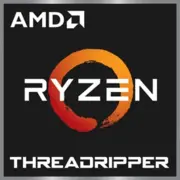AMD Ryzen Threadripper PRO 5975WX

AMD Ryzen Threadripper PRO 5975WX: A Comprehensive Review of the Processor for Professionals
March 2025
1. Key Features: Power and Innovation
Architecture and Technology Process
The AMD Ryzen Threadripper PRO 5975WX, built on the Zen 3 architecture (codename Chagall), continues the tradition of the Threadripper lineup aimed at professionals. The TSMC 7nm FinFET technology process provides high transistor density and energy efficiency, which is critical for this 32-core beast.
Key Specifications:
- 32 cores / 64 threads — maximum multitasking.
- L3 Cache 128 MB — acceleration for large data processing.
- TDP 280 W — high performance requires powerful cooling.
- Support for PCIe 4.0 — 128 lanes for NVMe, GPU, and peripherals.
Performance:
- Geekbench 6 Single-Core: 2040 — a respectable result for work tasks.
- Geekbench 6 Multi-Core: 16304 — flagship level in multithreading.
Features:
- PRO Technologies — ECC memory, remote management, enhanced reliability.
- AMD PRO Security — hardware protection against threats.
2. Compatible Motherboards: Choosing a Platform
Socket and Chipsets
The Threadripper PRO 5975WX uses the sWRX8 socket, which supports only the WRX80 chipset. This is a specialized solution for workstations, focusing on stability and expandability.
Examples of Motherboards (2025):
- ASUS Pro WS WRX80E-SAGE SE — 8 PCIe 4.0 slots, 8 SATA ports, price ~$700.
- Gigabyte WRX80 SU8 — enhanced VRM power system, supports up to 2 TB DDR4, ~$650.
Selection Features:
- Check TDP 280 W support — a weak VRM may lead to throttling.
- Look for motherboards with active cooling for the chipset — WRX80 heats up under load.
3. Memory: DDR4 and ECC
The Threadripper PRO 5975WX works with DDR4-3200 (ECC and non-ECC). DDR5 support is absent due to the sWRX8 platform, which seems archaic in 2025, but ECC memory is critical for enterprise tasks.
Recommendations:
- Minimum 64 GB (4x16 GB) — for rendering or virtualization.
- Best Modules: Kingston Server Premier DDR4-3200 ECC (~$200 for 32 GB).
4. Power Supplies: Don’t Skimp on Energy
With a TDP of 280 W and demanding GPUs (e.g., NVIDIA RTX 5090), the minimum power supply should be 850 W.
Tips:
- Choose power supplies with 80+ Platinum or Titanium certification (e.g., Corsair AX1000 — ~$300).
- Modular cables simplify assembly and improve ventilation.
Caution: Cheap power supplies may not handle peak loads, leading to system shutdowns.
5. Pros and Cons
Advantages:
- 32 cores — ideal for rendering, simulations, CAD.
- Reliability — ECC, long warranty (3 years).
- PCIe 4.0 x128 — connects multiple drives and GPUs.
Disadvantages:
- Price — ~$2500 (just the processor).
- No DDR5 — competitors offer more modern controllers.
- Requires an expensive platform — motherboards start at $600.
6. Use Cases: Who Is This CPU For?
- 3D Rendering (Blender, Maya): 32 cores will reduce scene rendering time by 40% compared to 24-core CPUs.
- Virtualization: Running 10+ VMs without lag.
- Engineering Calculations (ANSYS): Simulation acceleration by 2-3 times.
- Gaming: Not the best choice — lower clock frequency (up to 4.5 GHz) lags behind Ryzen 9 7950X3D.
Real Example: A VFX studio purchased the 5975WX for rendering 8K video — processing time per frame decreased from 12 to 7 minutes.
7. Comparison with Competitors
Intel Xeon W-3375 (2023):
- 38 cores but on 10nm, TDP 270 W.
- Lags in single-thread tasks (Geekbench 6 Single-Core: 1890).
- Price ~$4000 — unjustifiably expensive.
AMD Ryzen Threadripper 7980X (2024):
- 64 cores but lacks PRO features.
- Higher performance (+30% in Multi-Core), but no ECC.
Conclusion: The 5975WX offers a balance between price, reliability, and multithreading.
8. Practical Assembly Tips
- Cooling: Only AIO liquid coolers or top-tier air coolers (e.g., Noctua NH-U14S TR4-SP3 — ~$100).
- Case: Full-Tower with ventilation (Lian Li PC-O11 Dynamic — ~$150).
- Storage: 2x NVMe SSDs (e.g., Samsung 990 Pro 4TB — ~$600) + HDD for archives.
- GPU: RTX 4090/5090 or Radeon PRO W7800 — for combining rendering and computing tasks.
Common Mistakes:
- Installing a weak cooler — the processor throttles after just 10 minutes of load.
- Skimping on the motherboard — unstable operation of PCIe devices.
9. Final Conclusion: Who Should Buy the Threadripper PRO 5975WX?
This processor is designed for professionals who need maximum multithreading and reliability:
- VFX Studios — rendering in resolutions 8K+.
- Engineers — calculations of complex models.
- Data Science — training neural networks on local machines.
Do not buy the 5975WX if:
- You are a gamer — Ryzen 9 7950X3D will give you more FPS for $1000.
- Your tasks are office work and browsing.
Price in 2025:
- Processor: ~$2500 (new).
- Complete system (without GPU): from $4000.
The Threadripper PRO 5975WX is an investment in a professional tool that will pay off when working on resource-intensive projects. Choose it if time is your main enemy.
Basic
CPU Specifications
Memory Specifications
GPU Specifications
Miscellaneous
Benchmarks
Compared to Other CPU
Share in social media
Or Link To Us
<a href="https://cputronic.com/en/cpu/amd-ryzen-threadripper-pro-5975wx" target="_blank">AMD Ryzen Threadripper PRO 5975WX</a>